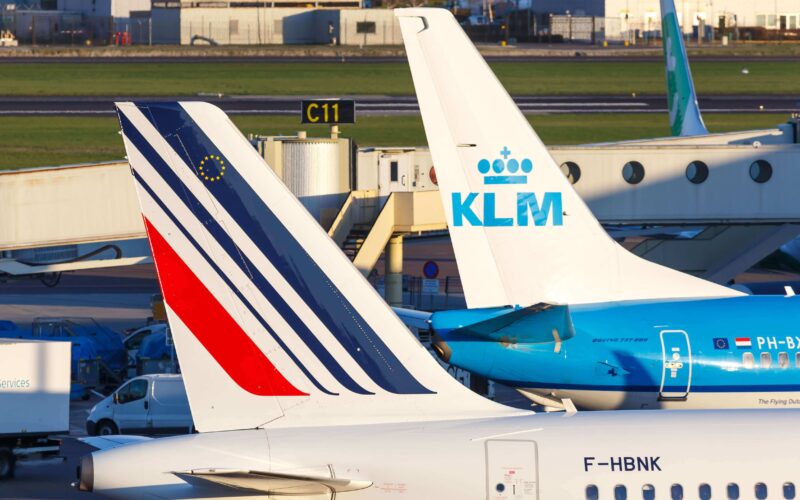On May 5, 2004, Air France and KLM airlines merged to create the AirFrance-KLM Group in an €800m deal, which, at the time, created the world’s largest airline in terms of turnover.
Despite the merger, the two airlines retained their own unique branding and individuality while establishing themselves as one of Europe’s largest airline groups.
KLM Royal Dutch Airlines
In August 1919, Albert Plesman organized the Eerste Luchtverkeer Tentoonstelling Amsterdam (ELTA) exhibition. Opened by Queen Wilhelmina of the Netherlands, the exhibition attracted more than half a million visitors. The event created such enthusiasm for aviation that on October 7, 1919, eight Dutch businessmen founded what is now considered to be the world’s oldest airline and still uses its original name.
KLM’s first flight operated from London to Amsterdam Airport Schiphol, flying a leased De Havilland DH-16. On board were two journalists and a bundle of newspapers.
In July 1989, KLM began developing a global reaching network when it acquired a 20% stake in U.S. carrier Northwest Airlines. At the time, Northwest Airlines was one of the big four airlines in North America. By 1993, KLM and Northwest Airlines transatlantic flights were operated as a joint venture known as the Wings Alliance.
Air France
Air France was formed on the October 7, 1933, following the merger of five airlines, including France’s oldest airline Société Générale des Transports Aériens (SGTA). Spanning almost nine decades, Air France has a rich history, having flown iconic aircraft such as the Boeing 747 as well as being the world’s first operator of the Airbus A300 aircraft.
Air France has a unique place in aviation as one of only two airlines to have operated Concorde flights, with its inaugural supersonic service from Paris to Rio on January 21, 1976. Concorde flew regular services from Paris to New York with Air France until its retirement in 2003.
In order to remain competitive during the deregulation of European airspace, which began in the late 1980s, the French government advocated for Air France to acquire the French airline, Union de Transports Aériens (UTA) in January 1990. Air France went on to merge with Air Inter in 1997 and the Air France Group was born.
The merger
By the late 1990s, KLM was keen to extend its alliances and, in November 1999, KLM and Alitalia formed a partnership intended to create Europe’s largest airline. However, by April 2000, KLM had severed ties with Alitalia, costing the company more than €170 million in settlements.
Faced with economic downturn and mounting debts, KLM began talks with British Airways, which had recently founded the Oneworld alliance alongside founding member American Airlines (A1G) (AAL). However, no developments were made. KLM ruled out Lufthansa (LHAB) (LHA) as a possible partner and so, there was only one remaining alliance left, SkyTeam.
Air France and Delta had spearheaded alliance discussions and, in June 2000, founded the third global alliance, SkyTeam. It was in late 2003, when, following discussions, KLM and Air France announced a deal in the form of a merger.
The merger gained approval from the European Commission in February 2004 and Air France-KLM Group was founded on May 5, 2004.
Air France-KLM
The Air France-KLM group is owned by shareholders, of which the French State is the largest, with a 28.6% stake, while the Dutch State currently holds 9.3%.
Throughout the COVID-19 pandemic, Air France-KLM received more than €10bn in state aid from the French and Dutch governments and has recently announced plans to begin repaying its state-backed aid packages.
As a result of the pandemic, Air France and KLM made the decision to retire their Boeing 747 and Airbus A380 aircraft and make heavy job cuts throughout the company.
Today, the group is one of the largest airlines in Europe carrying more than 44 million passengers in 2021, (104 million passengers in 2019). With bases at Paris-Charles de Gaulle and Amsterdam Schiphol airport, the two brands and their subsidiaries have a combined fleet of 536 aircraft flying to more than 300 destinations worldwide.
The airlines operate a mixture of Boeing and Airbus aircraft, including next generation A220, A350 and B787 aircraft.
In December 2021, the group placed an order for 100 Airbus A320neo and A321neo aircraft, with purchase rights for an additional 60 aircraft. The latest generation Airbus are expected in the second half of 2023 and will replace the fleet’s ageing 737 aircraft.
On April 12, 2022, Air France confirmed an order for 4 Airbus A350F freighter aircraft with options for an additional four. The A350F will be used to replace older 777F aircraft in its cargo fleet.

